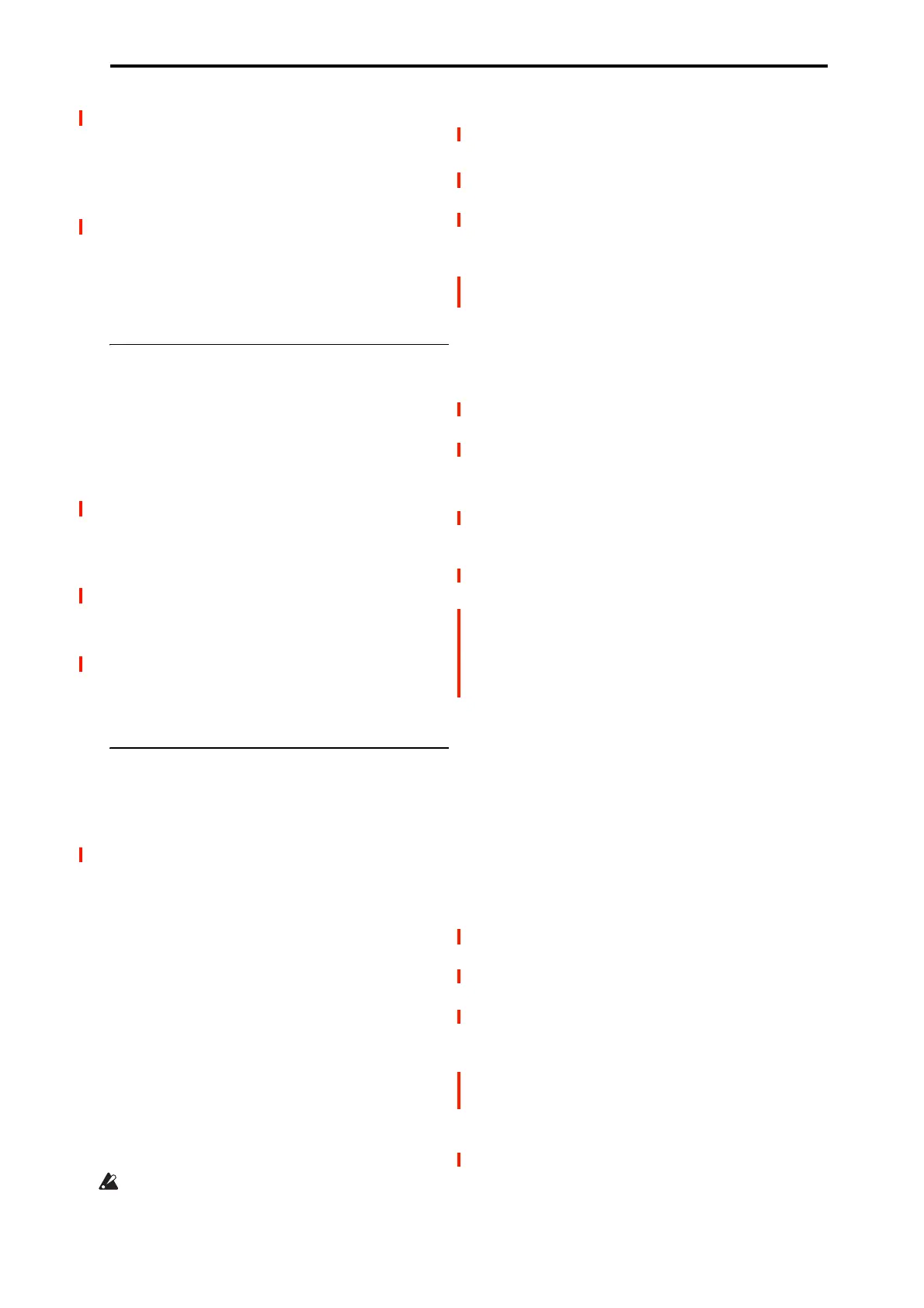GLOBAL > Wave Sequence 4–2: Step Parameter
667
Swing [–300%…+000…+300%]
Swing adjusts the position of the up-beats, relative to the
Wave Sequence’s Resolution setting. This parameter applies
only when the Mode is set to Tempo.
For more information, please see “Swing,” on page 663.
Quantize Triggers [Off, On]
This parameter allows you to force most Tempo-mode Wave
Sequence note-ons to be in sync, making it easier to play
along with other rhythmic elements. It applies only when the
Mode is set to Tempo. For more information, please see
“Quantize Triggers,” on page 663.
4–2b: Graphic
The graphic gives you a visual overview of the Wave
Sequence. There’s one addition from the graphic shown on
the other page: a scroll-bar over the top of the graphic shows
the 8 currently displayed steps.
For more information, please see “4–1b: Graphic,” on
page 664.
Step [1…64]
This selects the current step, which applies to the Cut, Copy,
Paste, and Insert commands.
Multisample (Read-Only) [Bank, Number,
and Name]
This shows the bank, number, and name of the current step’s
Multisample.
Solo [Off, On]
This button solos the current step, so that you can hear it
quickly and easily. When Solo is On, the Wave Sequence
will play only the current step, as if Run were Off.
4–2c: Step parameters
This list shows the parameters for eight steps at a time. Use
the scroll bar at the right of the screen to change which steps
are in view.
Type [Multisample, Rest, Tie]
This sets the step to one of three basic types.
Multisample means that the step will sound a new
Multisample, as set by the Multisample Select parameter,
below.
Rest means that the step will be silent.
Tie is an alternate way of creating rhythmic values, which
may sometimes be more convenient than using the Base
Note and x (Multiply Base Note By) parameters. Steps set to
Tie simply extend the duration of the previous step; all
parameters other than Duration, Crossfade, and Fade-Out
Shape will be grayed out.
Additionally, the Crossfade and Fade-Out Shape settings
of the previous step have no effect.
Multisample Select [List]
This menu selects the step’s Multisample.
Some Multisamples may have an upper limit to their
keyboard range, above which they may not produce any
sound.
When the Multisample Select window is open, you can use
the Find button to search for Multisamples by name. For
more information, see “Find dialog” on page 7.
Bank (Multisample) [List of Multisample Banks]
There are four types of Multisample Banks: ROM,
SAMPLING mode, EXs, and User Sample Banks.
ROM Multisamples are the built-in “factory” sounds, and
are always available.
Smp (SAMPLING Mode) Multisamples are the ones that
you can see and edit in SAMPLING mode. After the
abbreviation “Smp,” several different things may appear, as
described below.
Smp: Old RAM means that this is an older Program
pointing to the legacy “RAM” bank. Instead of pointing to a
specific User Sample Bank, it will use whatever
Multisample data is loaded into SAMPLING mode.
Smp: New Sampling Session will appear when there’s data
in SAMPLING mode which hasn’t yet been saved to drive as
a User Sample Bank. For instance, this might happen if
you’ve loaded an old KSC file, loaded individual Samples or
Multisamples, or recorded some new samples. Once the
KSC is saved to drive, the name will update to show the file
path (as described below).
Smp: [file name] will appear when a User Sample Bank has
been loaded into SAMPLING mode. The name is the file
name itself along with those of all its enclosing folders.
EXs Multisample banks are PCM expansion sets created
especially for the NAUTILUS. Each has its own unique
number; for instance, the ROM Expansion is EXs1. Only the
currently loaded EXs banks will appear on this menu.
User Sample Banks bring the benefits of EXs to your own
sample libraries. You can load and play gigabytes of your
custom or converted samples at once, using Virtual Memory.
The name is shown as a path to the KSC file, including the
file name and the names of all enclosing directories. Only
the currently loaded User Sample Banks will appear in this
menu.
If a sound refers to a User Sample Bank which is not on the
internal drive(s), the name will appear as “Unknown Sample
Bank [number]” when the bank select dialog is open,
shortened to “??[number]” when the dialog is closed.
For more information, see “User Sample Banks” on
page 149 of the OG.
Start Offset [Off, 1st…8th]
In addition to simply starting playback from the beginning,
ROM and EXs Multisamples can have up to 8 different pre-
programmed alternate starting points, called Start Offsets.
Similarly, SAMPLING mode and User Sample Bank
Multisamples can play either from the beginning of the
waveform, or from the loop start point.
Start Offsets: ROM and EXs
With ROM and EXs Multisamples, the Start Offset specifies
whether to use the normal start point (Off), or to use one of
the alternate start points (1st–8th).
Some ROM and EXs Multisamples may have fewer than 8
pre-programmed points, in which case only the available
points can be selected.

